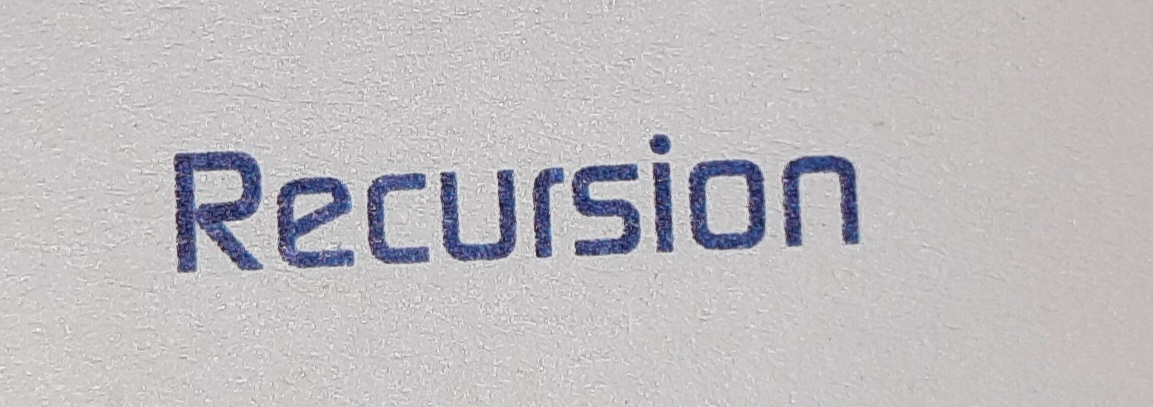# The Concept of Recursion: A Deep Dive
Recursion is a fundamental and powerful concept in computer science and mathematics. It is a problem-solving technique and a programming paradigm that involves solving a problem by breaking it down into smaller, self-similar subproblems. These subproblems are solved using the same algorithm, ultimately leading to the solution of the original problem. Recursion is a concept that appears in various aspects of computer science, from algorithms and data structures to programming languages and artificial intelligence. In this article, we will explore the concept of recursion in depth, examining its principles, applications, advantages, and limitations.
## I. Understanding Recursion
### 1. The Basic Idea
At its core, recursion is a process where a function calls itself as part of its own execution. This may sound counterintuitive at first, but it is a powerful tool for solving complex problems by breaking them down into simpler instances. To better understand recursion, let's explore its key components:
- **Base Case:** Every recursive algorithm must have a base case or termination condition. This is the point at which the recursion stops. Without a base case, the recursion would continue indefinitely, resulting in a stack overflow or infinite loop.
- **Recursive Case:** In addition to the base case, a recursive algorithm also has one or more recursive cases. These are the conditions under which the function calls itself. Recursive cases break down the problem into smaller, more manageable subproblems.
### 2. Visualizing Recursion
To illustrate the concept of recursion, consider the classic example of computing the factorial of a positive integer `n`. The factorial of `n`, denoted as `n!`, is the product of all positive integers from 1 to `n`. The factorial function can be defined recursively as follows:
```python
def factorial(n):
# Base case: If n is 0 or 1, return 1
if n <= 1:
return 1
# Recursive case: Multiply n by the factorial of (n-1)
else:
return n * factorial(n - 1)
```
Here, the base case is when `n` is 0 or 1, in which case the factorial is 1. In the recursive case, the function calls itself with a smaller value of `n` and multiplies the result by `n`. The recursion continues until the base case is reached, and then the results are combined to compute the final factorial.
### 3. The Call Stack
Recursion is often implemented using a call stack, a data structure that keeps track of function calls. When a function is called, its state is pushed onto the stack, and when it returns, its state is popped off the stack. In the case of recursion, each recursive call adds a new frame to the stack.
Consider the `factorial` function with the input `n = 5`:
```
factorial(5)
-> factorial(4)
-> factorial(3)
-> factorial(2)
-> factorial(1)
-> factorial(0)
<- return 1
<- return 1
<- return 2
<- return 6
<- return 24
```
This stack shows the sequence of recursive calls and returns as the function progresses. The final result, `factorial(5)`, is computed as the product of all the returns, giving us 120.
## II. Applications of Recursion
Recursion is a versatile technique that finds applications in various domains within computer science and mathematics. Here are some of the key areas where recursion is commonly used:
### 1. Mathematics
- **Factorials and Combinatorics:** As shown earlier, factorials can be computed recursively. Recursion is also used in combinatorial problems such as permutations and combinations.
- **Fibonacci Sequence:** The Fibonacci sequence is often defined recursively, where each term is the sum of the previous two terms: `F(n) = F(n-1) + F(n-2)`.
- **Fractals:** Fractals like the Koch snowflake and the Sierpinski triangle are generated recursively.
### 2. Computer Science
- **Sorting Algorithms:** Recursive algorithms like Merge Sort and Quick Sort are widely used for sorting data.
- **Binary Trees:** Binary search trees and binary tree traversal algorithms (e.g., inorder, preorder, postorder) are defined recursively.
- **Graph Algorithms:** Many graph algorithms, such as Depth-First Search (DFS) and Breadth-First Search (BFS), can be implemented using recursion.
- **Dynamic Programming:** Recursive solutions are often the basis for dynamic programming algorithms, which optimize problems with overlapping subproblems.
### 3. Programming Languages
- **Function Calls:** Functions in many programming languages can call themselves, allowing for recursive implementations.
- **Tail Recursion:** Some programming languages optimize tail-recursive calls, where the recursive call is the last operation in the function. This optimization helps avoid stack overflow errors.
### 4. Artificial Intelligence
- **Search Algorithms:** In AI, recursive algorithms are used in search and planning algorithms like A* search and minimax for game playing.
- **Neural Networks:** Some neural network architectures, like recurrent neural networks (RNNs), have a recursive structure that allows them to process sequences of data.
## III. Advantages of Recursion
Recursion offers several advantages in problem-solving and programming:
### 1. Simplicity and Readability
Recursive algorithms often provide a more intuitive and readable way to solve complex problems. By expressing a problem in terms of smaller, self-similar subproblems, the code mirrors the problem's inherent structure.
### 2. Divide and Conquer
Recursion naturally follows the divide-and-conquer paradigm, breaking down problems into smaller parts. This can lead to efficient solutions, especially for problems with overlapping subproblems that can be memoized (i.e., cached) to avoid redundant work.
### 3. Abstraction and Reusability
Recursive functions can be abstracted to solve a wide range of problems. Once a recursive algorithm is defined, it can be reused for similar problems by modifying the base case and recursive case conditions.
### 4. Functional Programming
Recursion aligns well with functional programming principles, making it a valuable tool for functional programmers. Functional languages like Haskell heavily rely on recursion for looping and iteration.
## IV. Limitations and Considerations
While recursion is a powerful tool, it is not always the best choice for every problem. There are limitations and considerations to keep in mind:
### 1. Stack Usage
Recursive calls consume memory on the call stack, and excessive recursion can lead to stack overflow errors. Some languages optimize tail-recursive calls, but not all do.
### 2. Performance
Recursion can be less efficient than iterative solutions for certain problems. Iterative solutions often avoid the overhead of function calls and stack manipulation.
### 3. Readability
While recursion can enhance readability, overly complex recursive functions can become difficult to understand and maintain.
### 4. Choosing the Right Tool
Not all problems are naturally suited for recursion. It's important to evaluate whether a recursive or iterative approach is more appropriate for a given problem.
## V. Tail Recursion and Optimization
Tail recursion is a specific form of recursion where the recursive call is the last operation in the function. In this scenario, some programming languages optimize the recursion by reusing the current function's stack frame for the recursive call, effectively turning
the recursion into an iterative process. This optimization eliminates the risk of stack overflow for deep recursions.
Here's an example of a tail-recursive function to calculate the factorial of a number in a language that supports tail recursion optimization:
```python
def factorial_tail_recursive(n, accumulator=1):
if n <= 1:
return accumulator
else:
return factorial_tail_recursive(n - 1, n * accumulator)
```
In this version, the `accumulator` parameter is used to accumulate the result as the recursion progresses. The tail recursion optimization ensures that the function's stack frame is reused, making it efficient even for large values of `n`.
## VI. Common Recursion Patterns
Several common recursion patterns and techniques are frequently encountered when designing recursive algorithms:
### 1. Divide and Conquer
The divide-and-conquer strategy involves breaking down a problem into smaller subproblems, solving them independently, and combining their solutions to solve the original problem. Classic examples include Merge Sort and Quick Sort, which divide an array into smaller subarrays for sorting.
### 2. Memoization
Memoization is a technique where the results of expensive function calls are cached and reused when the same inputs occur again. This is particularly useful for dynamic programming, where overlapping subproblems exist. Memoization can greatly improve the efficiency of recursive algorithms.
### 3. Tree Traversal
When working with hierarchical data structures like binary trees or graphs, recursive algorithms are often used for traversal. Examples include depth-first search (DFS) and recursive tree traversals (inorder, preorder, postorder).
### 4. Backtracking
Backtracking is a technique used to find solutions to problems by incrementally building a solution and undoing it when it's determined that the current path cannot lead to a valid solution. Recursion is often employed to explore various possibilities in a systematic way.
### 5. Recursive Data Structures
Recursive data structures, like linked lists and trees, naturally lend themselves to recursive algorithms for operations like insertion, deletion, and traversal.
## VII. Examples of Recursion
To further illustrate the versatility of recursion, let's explore a few additional examples beyond the factorial function:
### 1. Computing Exponents
The power function can be defined recursively as follows:
```python
def power(base, exponent):
# Base case: If exponent is 0, return 1
if exponent == 0:
return 1
# Recursive case: Multiply base by power(base, exponent-1)
else:
return base * power(base, exponent - 1)
```
This function calculates `base^exponent` recursively.
### 2. Fibonacci Sequence
The Fibonacci sequence can be generated using a recursive function:
```python
def fibonacci(n):
# Base case: If n is 0 or 1, return n
if n <= 1:
return n
# Recursive case: Calculate Fibonacci(n-1) + Fibonacci(n-2)
else:
return fibonacci(n - 1) + fibonacci(n - 2)
```
This function returns the `n`th Fibonacci number.
### 3. Tower of Hanoi
The Tower of Hanoi puzzle is a classic example of a problem that can be solved using recursion. The goal is to move a stack of disks from one peg to another, subject to certain rules. A recursive algorithm can solve this puzzle efficiently.
### 4. Maze Solving
Recursive algorithms are commonly used to solve maze problems, where the goal is to find a path from a starting point to an exit point within a maze. Algorithms like depth-first search (DFS) employ recursion to explore possible paths.
## VIII. Conclusion
Recursion is a fundamental concept in computer science and mathematics, providing a powerful and elegant way to solve complex problems by breaking them down into smaller, self-similar subproblems. It finds applications in diverse areas, from mathematics and computer science to programming languages and artificial intelligence.
Understanding the principles of recursion, including base cases, recursive cases, and the call stack, is essential for harnessing its full potential. While recursion offers advantages such as simplicity, abstraction, and reusability, it also comes with limitations related to stack usage and performance. Therefore, choosing the right tool for the problem at hand is crucial.
By mastering recursion and its various patterns and techniques, programmers and mathematicians can tackle a wide range of problems efficiently and elegantly, making it a valuable skill in the world of computing and beyond.






